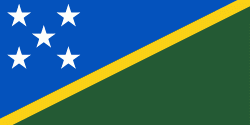Rennell and Bellona Province (Rennell and Bellona)
 |
In 1793, Bellona Island was named after a passing British ship, the Bellona. Rennell Island may have been named for the oceanographer James Rennell, FRS (1742–1830). In 1799, according to a chart, both islands were named Bellona Island. In 1816 the islands were referred to as Rennell's Isles.
The names the islanders used for self-reference are Mungiki (Bellona) and Mungava (Rennell), meaning 'small mountain' and 'large island' respectively (mu meaning 'island' or 'mountain', ngiki meaning 'small', and ngava meaning 'large'). Young people on both islands sometimes use the name Avaiki for both islands.
According to oral traditions, the islands were originally inhabited by a people of another culture before the ancestors of present-day Polynesians arrived in canoes from their homeland, ‘Uvea Gago (probably Ouvéa in the Loyalty Islands, New Caledonia). On their voyage, they arrived at ‘Uvea Matangi (probably East ‘Uvea, or Wallis Island, in Wallis and Futuna), and finally reached Rennell Island, where they found no inhabitants. They were told by a medium, Tahasi, that there was another island yet to be sighted and they left Rennell in search of it. They subsequently arrived at Bellona, where they found people, the Hiti, living in caves on the island near the shore. The Hiti were dark-skinned, short people with long hair reaching to their knees and spoke a language intelligible to the invaders, who gradually killed off the indigenous inhabitants. The oral traditions of Rennell and Bellona relate that the first invaders consisted of seven married couples who each founded a clan (sa’a), of which five became extinct. Ancestors of the two remaining clans, Kaitu’u and Iho, still inhabit the islands.
In oral traditions, narrators tell of scattered and singular voyages to and from other inhabited places in the Western Pacific. Just after settling, some men returned to East ‘Uvea (Wallis Island) to fetch precious turmeric root stocks that were used for ritual dyeing and anointment. In following generations two men went to Mungua (probably Woodlark Island, also known as Murua) and returned with place names and new kinds of yams and bananas. Another oral tradition details the arrival of a New Caledonian ship with tobacco and steel adzes. Other oral traditions state that poultry was brought to Rennell before the first Christian missionaries to the island were killed in 1910. In the latter part of the nineteenth century, Bellonese and Rennellese people were taken to Queensland by Blackbirders to work in the sugar plantations. One Rennellese man is known to have returned, bringing home with him Western goods such as axes, cotton cloth, umbrellas, and guns.
Initially, the two islands were contacted only sporadically by Europeans and Americans up to the later part of the nineteenth century. In 1910 the first three Christian missionaries were killed on Rennell, and the islands were left to themselves until preachers from the Seventh-day Adventists (SDA), the Church of England and the South Seas Evangelical Mission (SSEM) arrived in 1936. They took a group of Rennellese men to mission stations in other parts of Solomon Islands. In 1938, the Seventh Day Adventist Church became dominant on Rennell, followed by Bellona, which gradually converted all the inhabitants to Christianity. They destroyed all their heathen temples and built Christian churches all over the Islands.
Not until after World War II (1945) did Westernization slowly influence the two islands. A closer contact with the rest of Solomon Islands sped up the modernization process. More regular shipping was initiated, and children were sent to mission schools on other islands. In the 1950s health clinics and wireless contact were established on both islands. Regular air service to both islands was established in the beginning of the 1970s.
On July 7, 1978, Solomon Islands gained its independence from Great Britain, and Rennell and Bellona became part of the newly created country. About fifteen years later, Rennell and Bellona became a province of their own. At the turn of the millennium the different churches began losing their power, especially over the younger generation. Sports, music and home brewing became leisure-time interests, and education and vocational training rose in importance.
In 2005, there were reports that the people of Rennell and Bellona province were determined to secede from the country following a lack of infrastructure investment.
The history and linkage of the Rennellese people with the Māori are explored in a documentary entitled the "Mystery of the Lost Waka (canoe)", made by Maori TV in 2007.
Map - Rennell and Bellona Province (Rennell and Bellona)
Map
Country - Solomon_Islands
 |
 |
| Flag of the Solomon Islands | |
The islands have been settled since at least some time between 30,000 and 28,800 BCE, with later waves of migrants, notably the Lapita people, mixing and producing the modern indigenous Solomon Islanders population. In 1568, the Spanish navigator Álvaro de Mendaña was the first European to visit them. Though not named by Mendaña, it is believed that the islands were called "the Solomons" by those who later received word of his voyage and mapped his discovery. Mendaña returned decades later, in 1595, and another Spanish expedition, led by Portuguese navigator Pedro Fernandes de Queirós, visited the Solomons in 1606. Britain defined its area of interest in the Solomon Islands archipelago in June 1893, when Captain Gibson, R.N., of HMS Curacoa (1878), declared the southern Solomon Islands a British protectorate. During World War II, the Solomon Islands campaign (1942–1945) saw fierce fighting between the United States, British Commonwealth forces and the Empire of Japan, including the Battle of Guadalcanal.
Currency / Language
| ISO | Currency | Symbol | Significant figures |
|---|---|---|---|
| SBD | Solomon Islands dollar | $ | 2 |
| ISO | Language |
|---|---|
| EN | English language |















